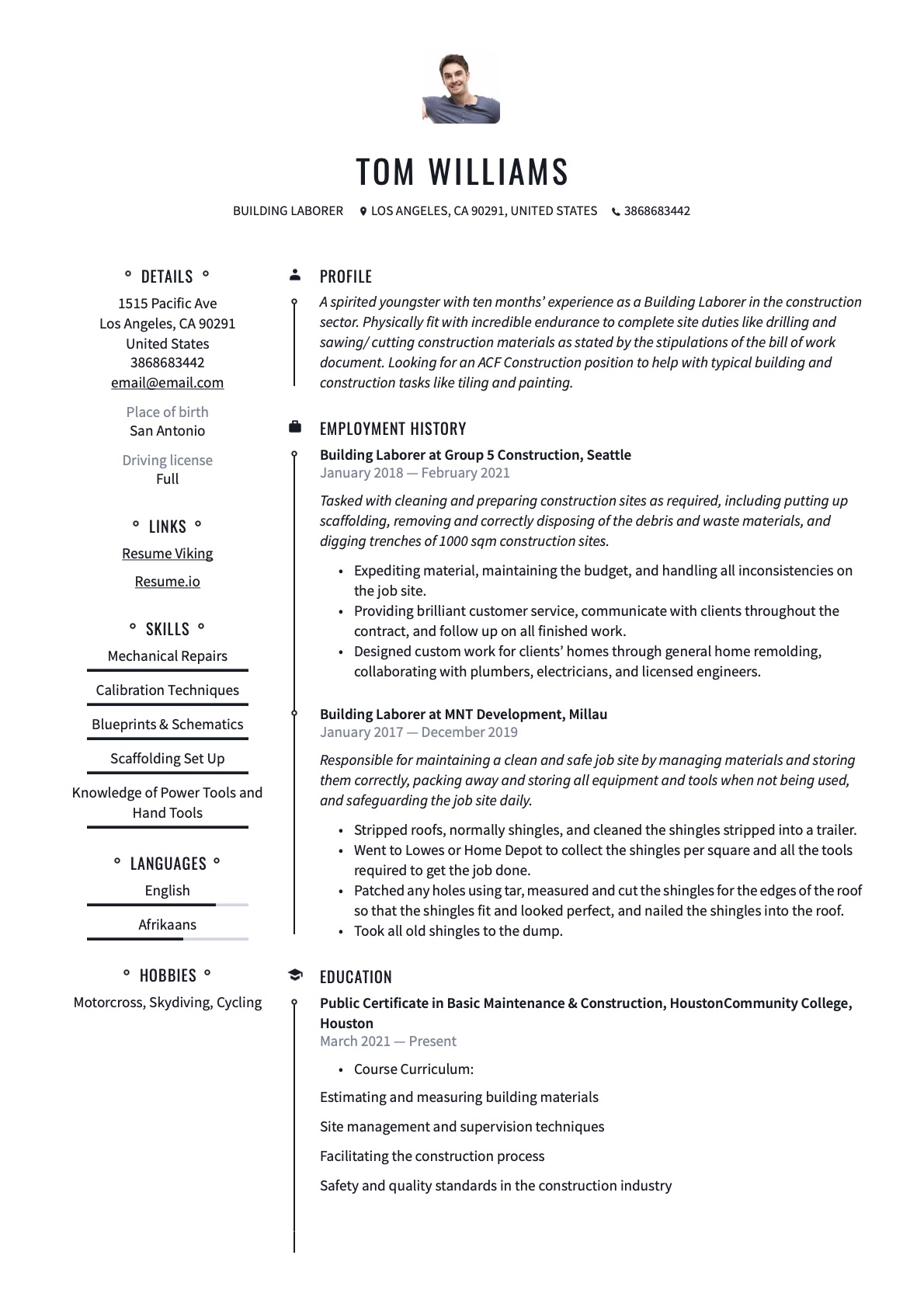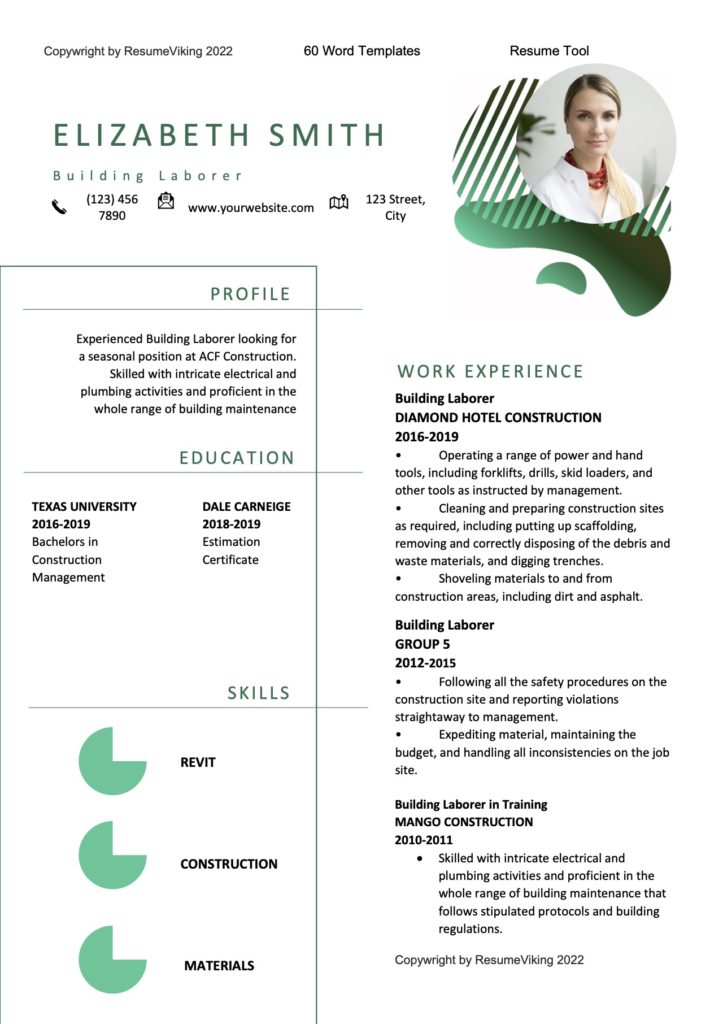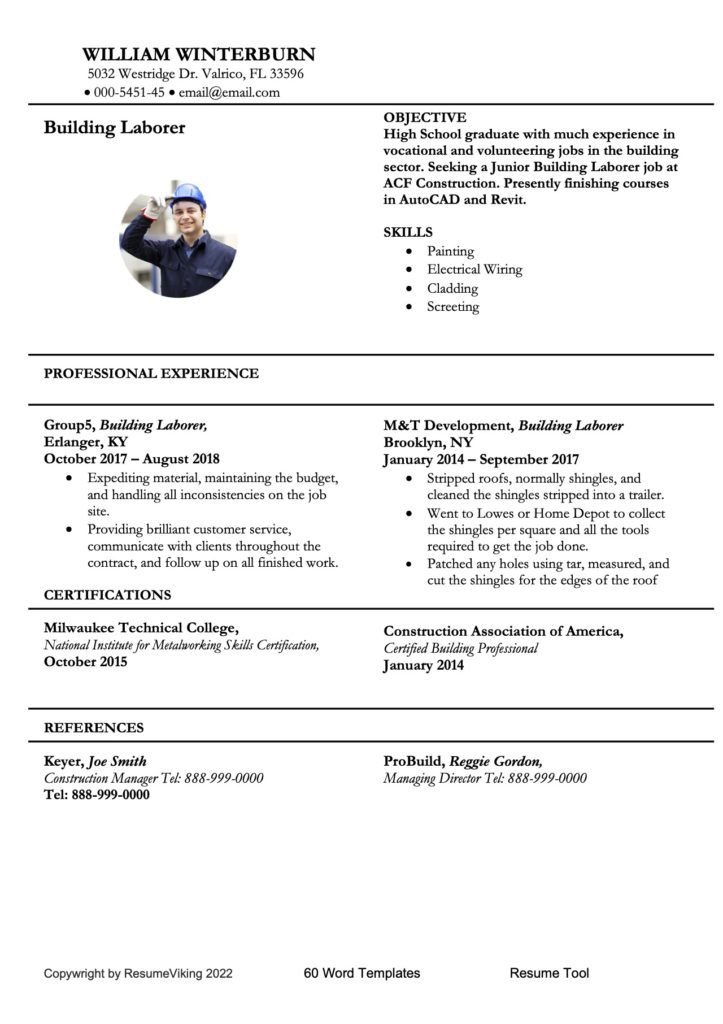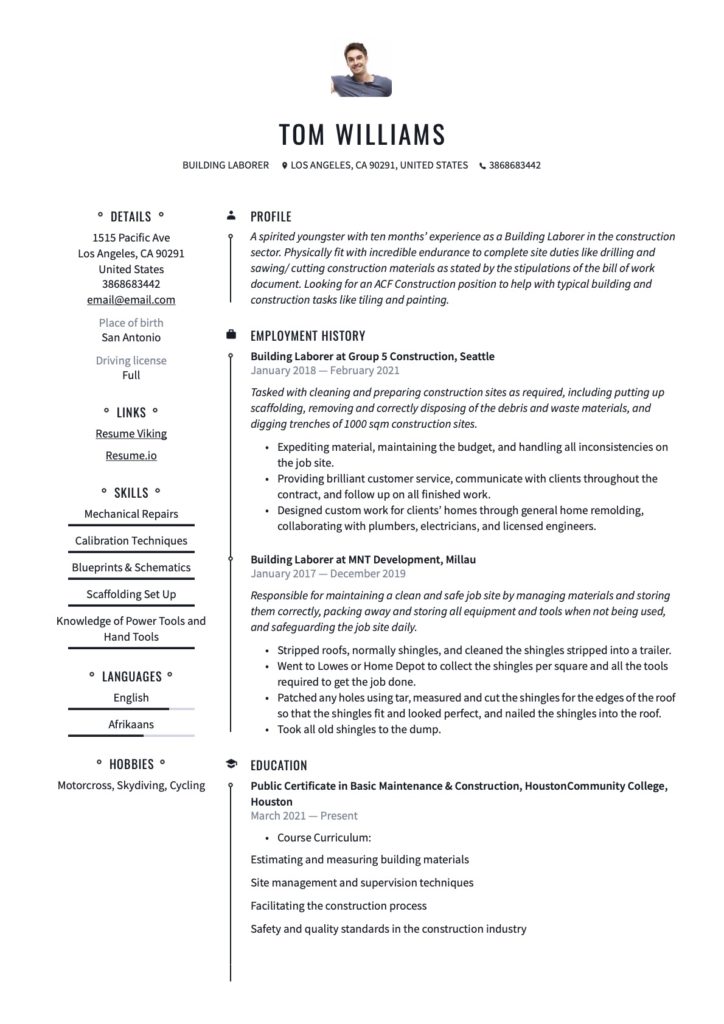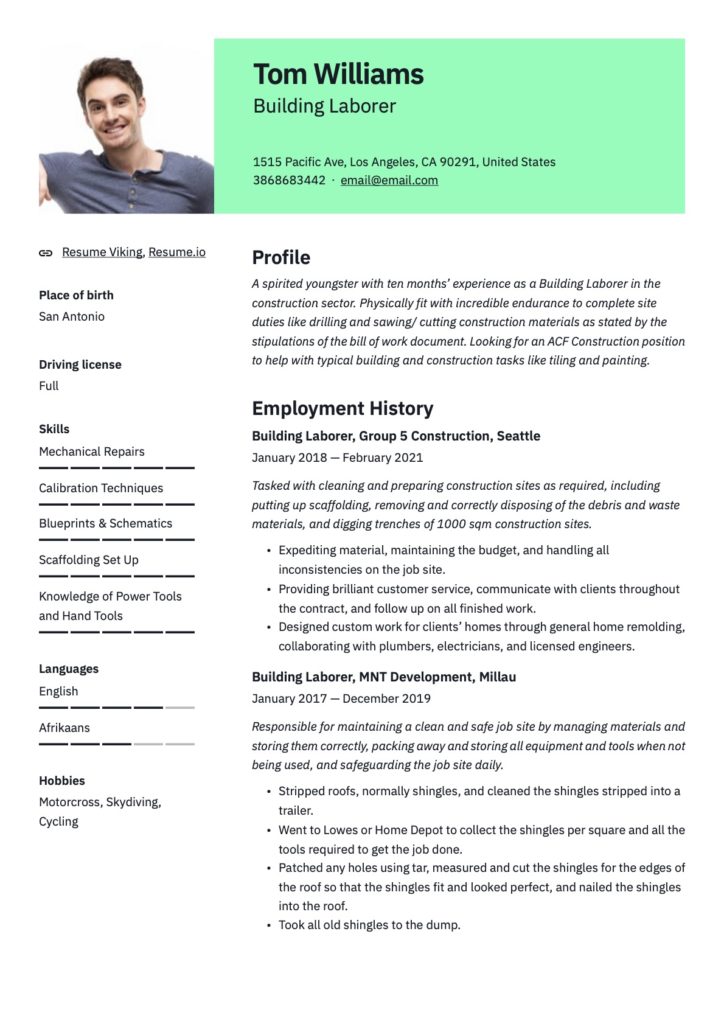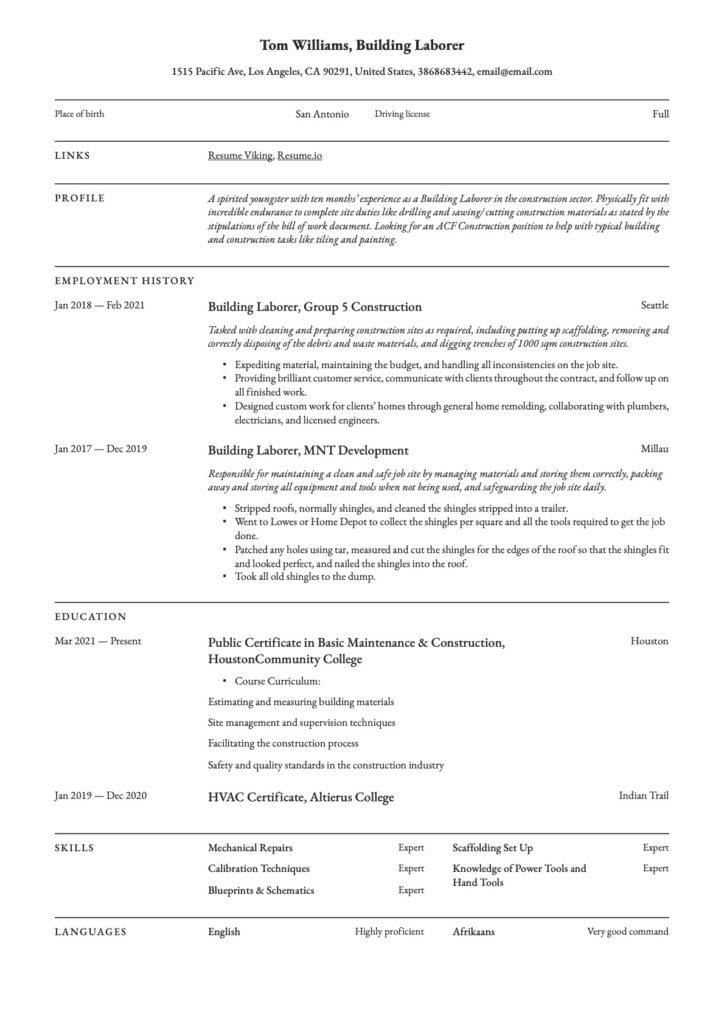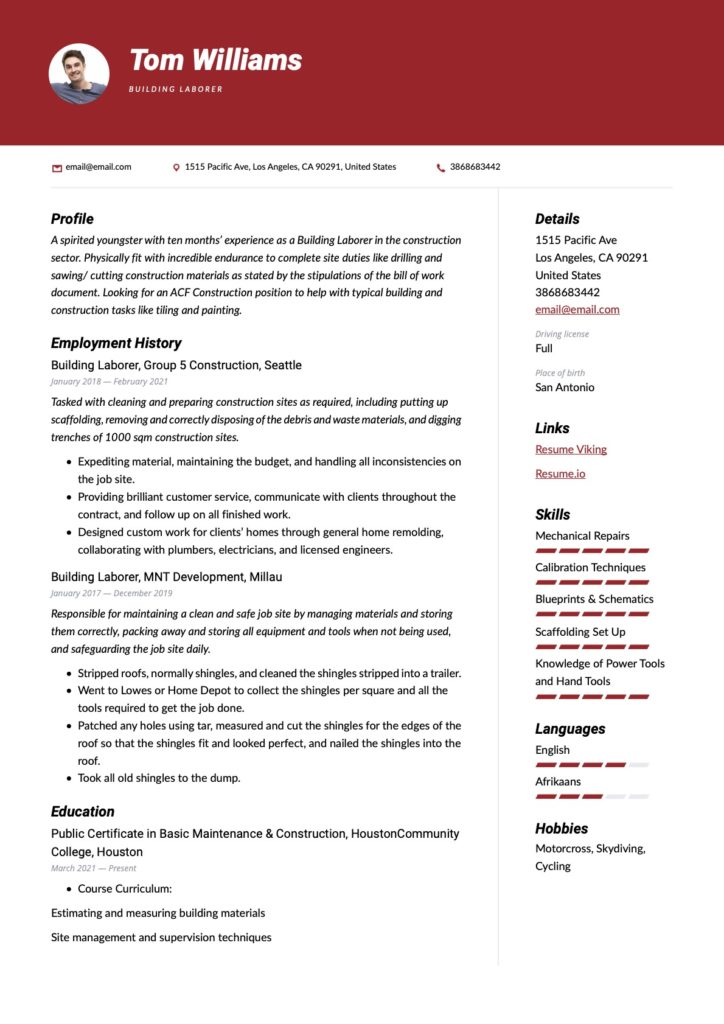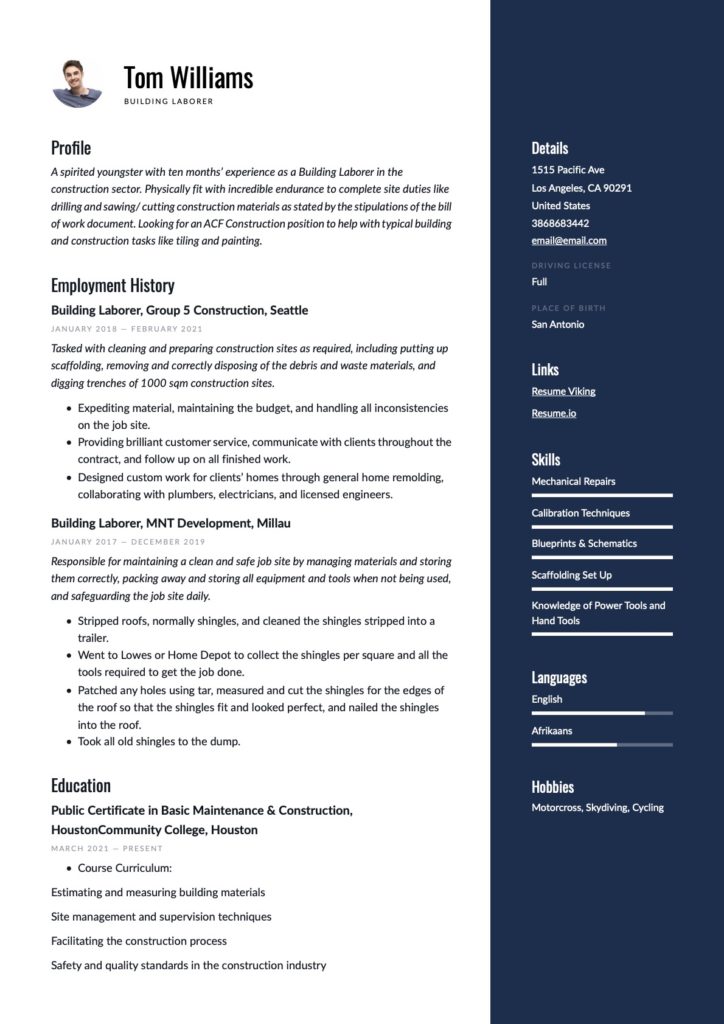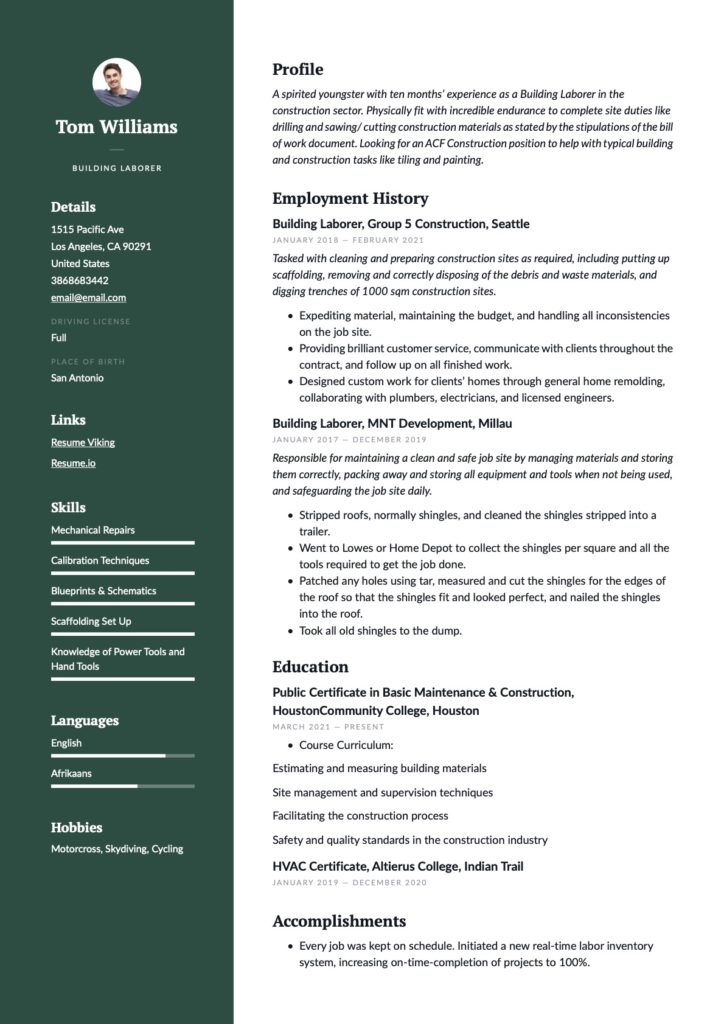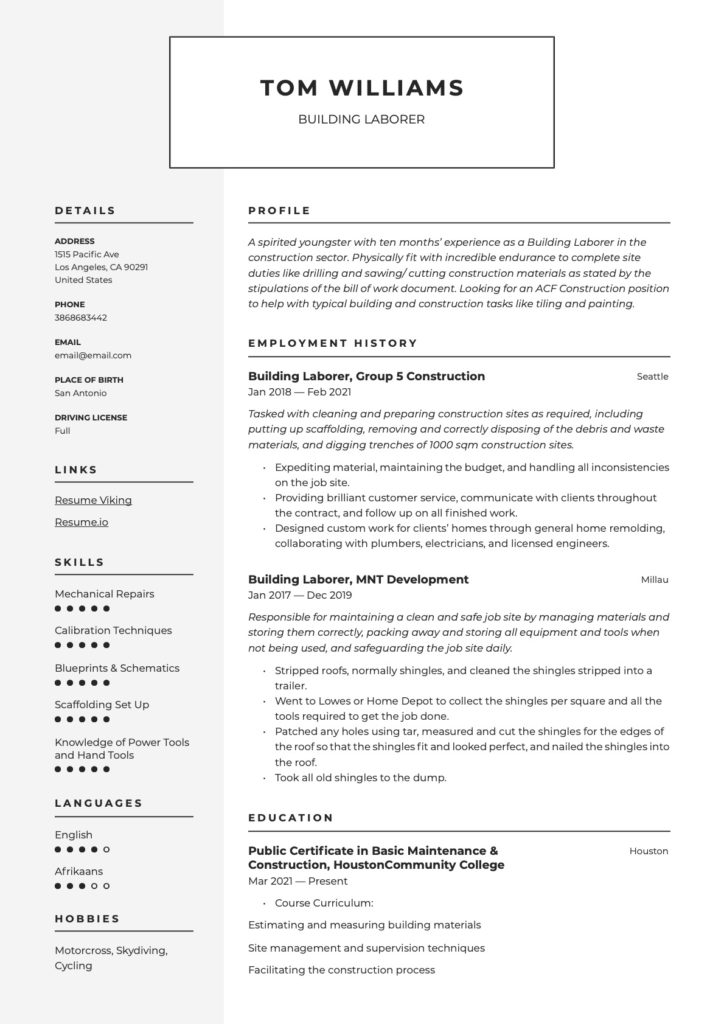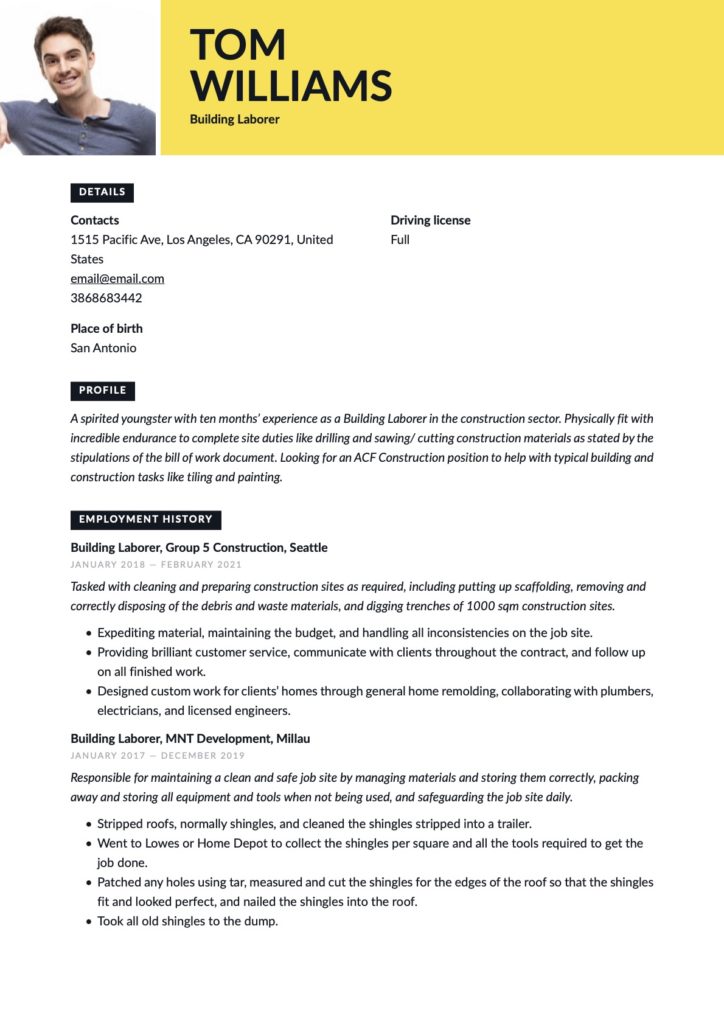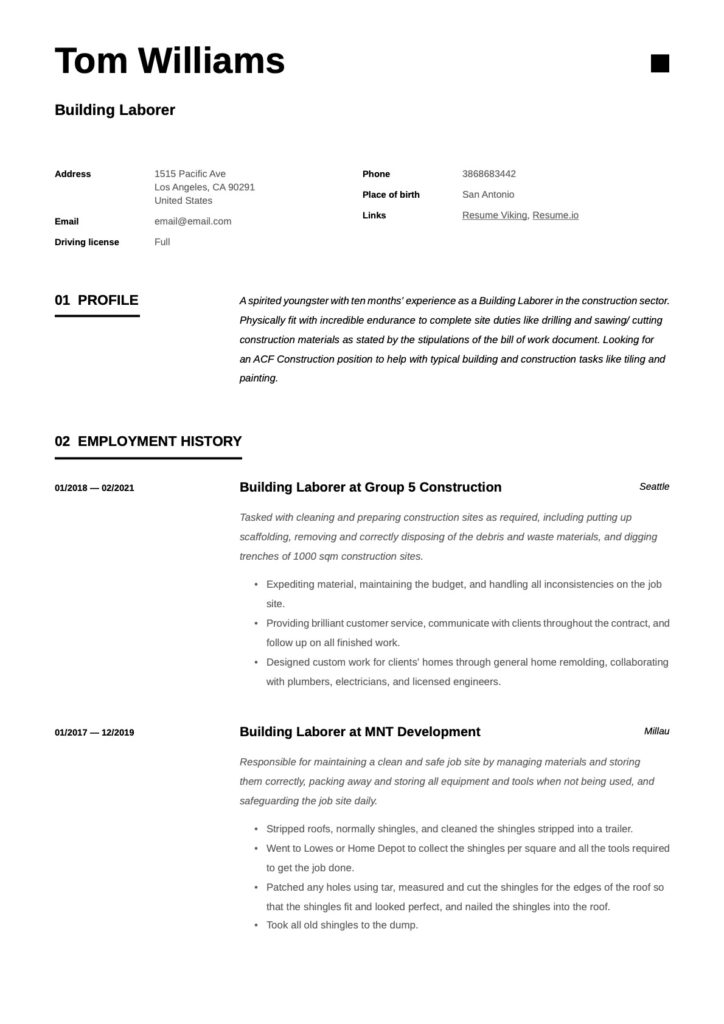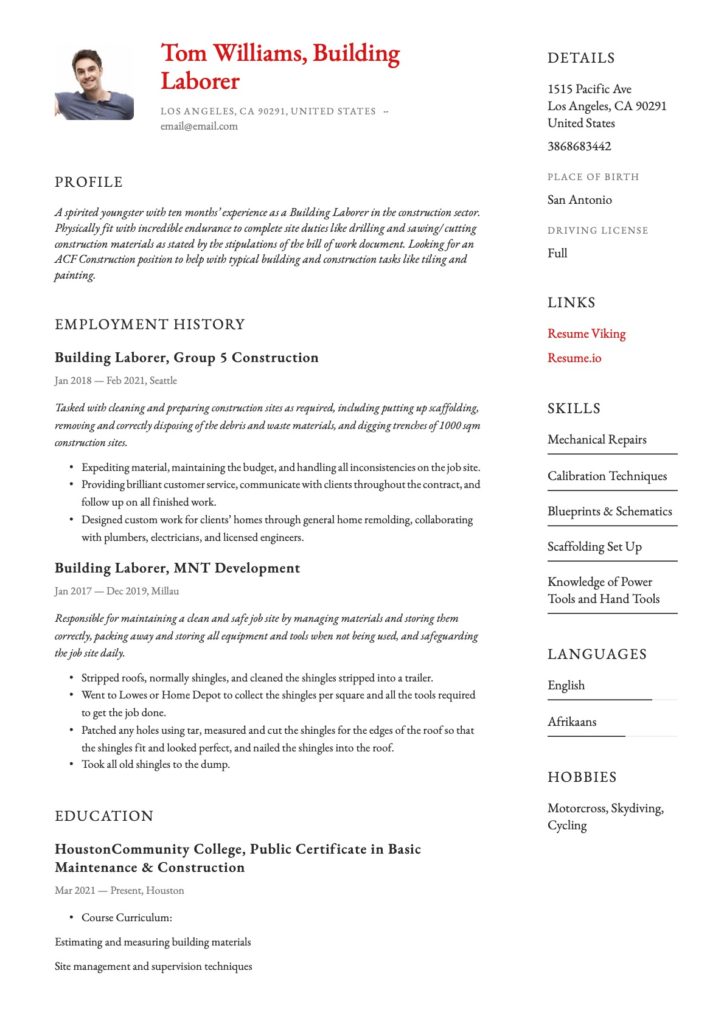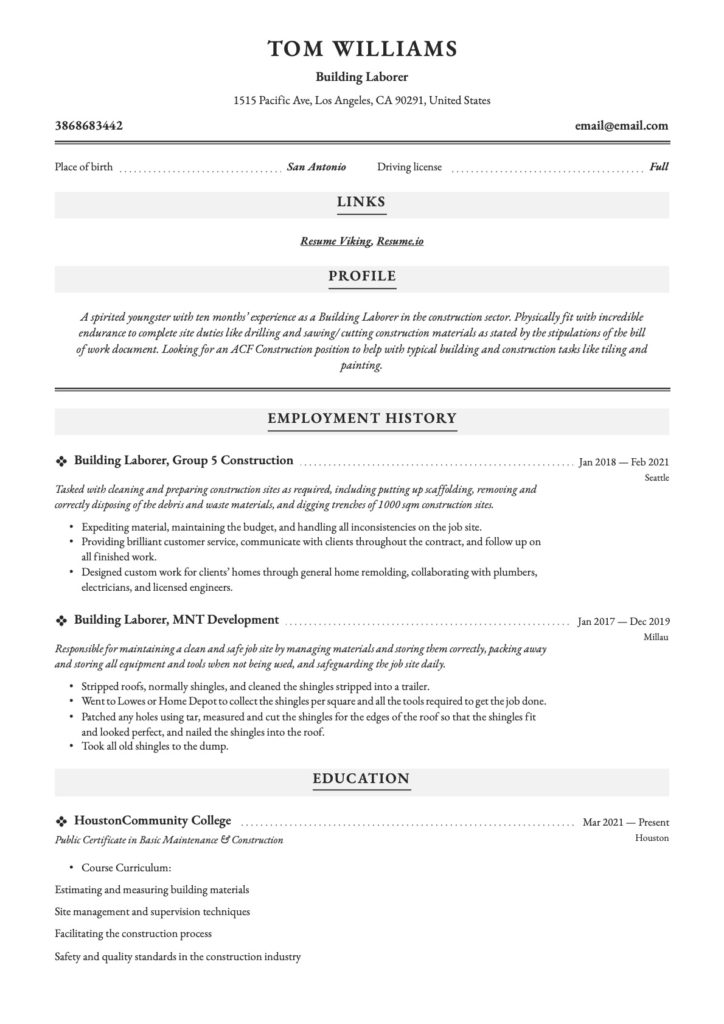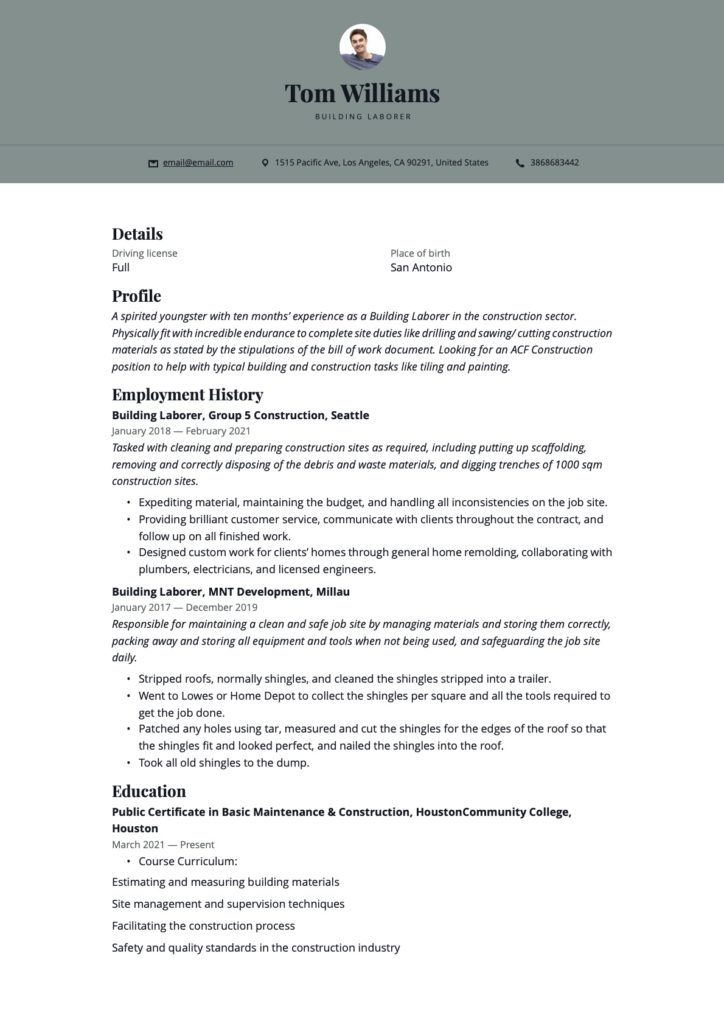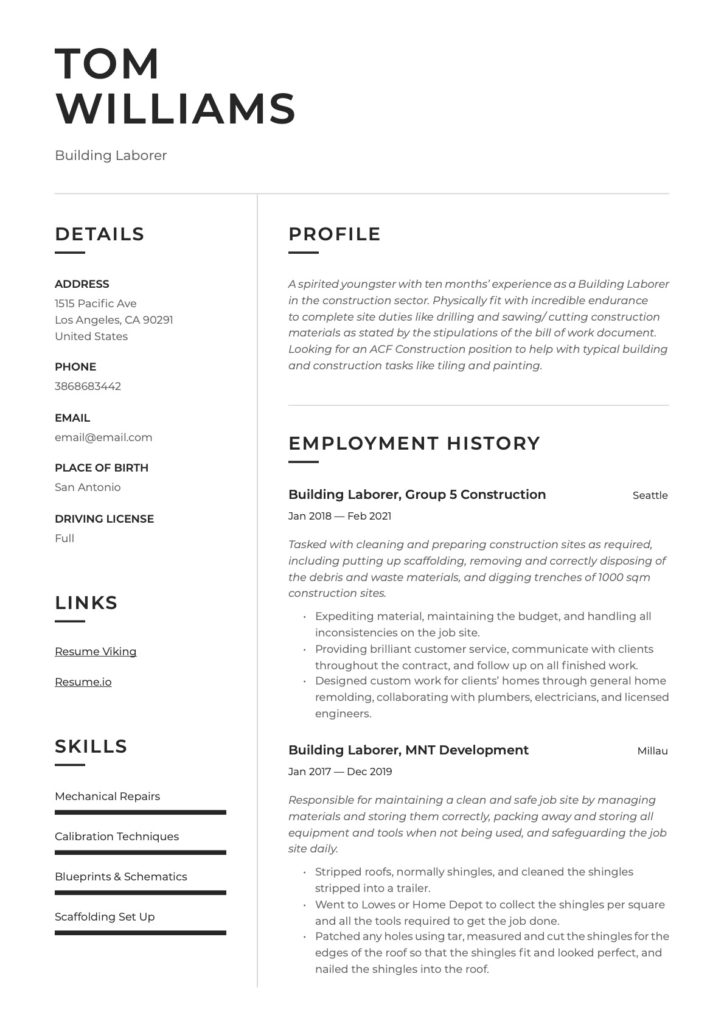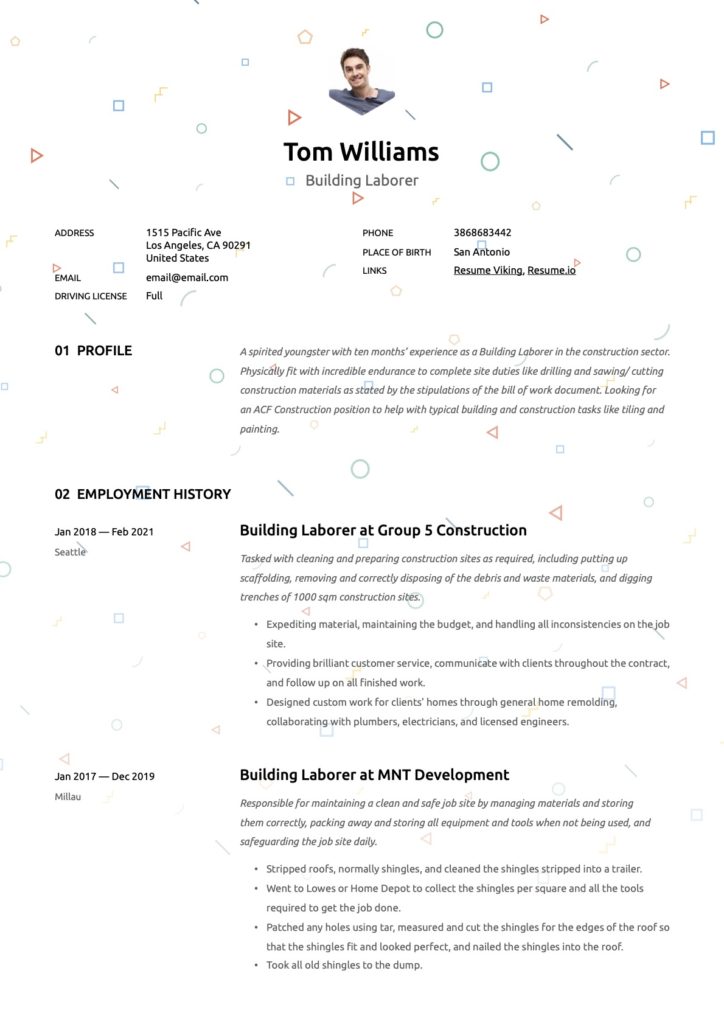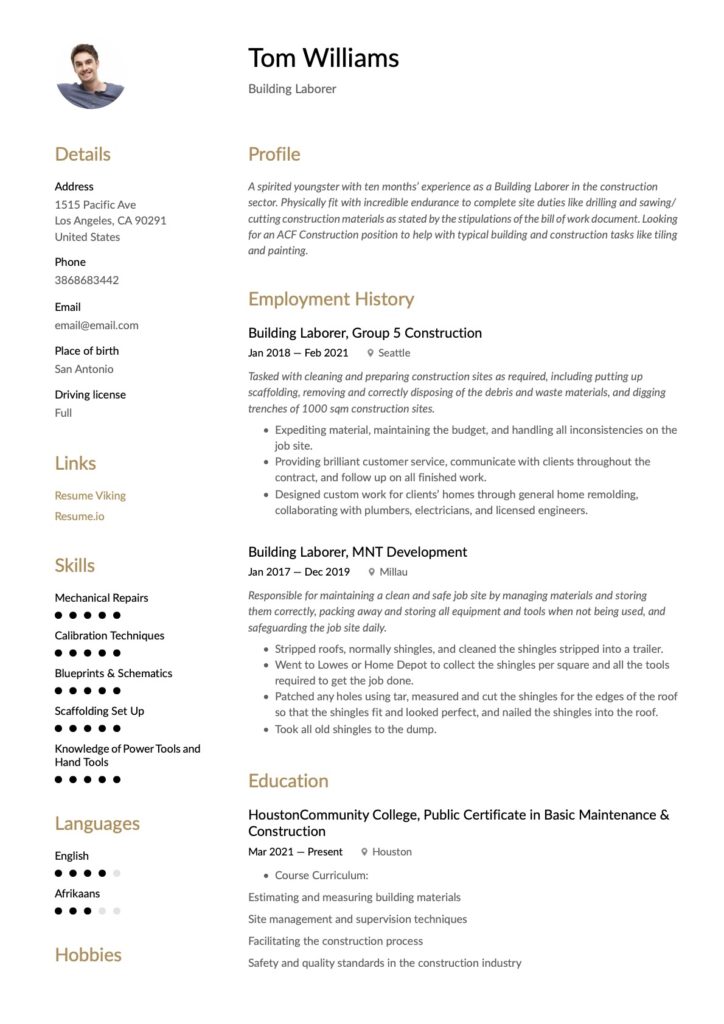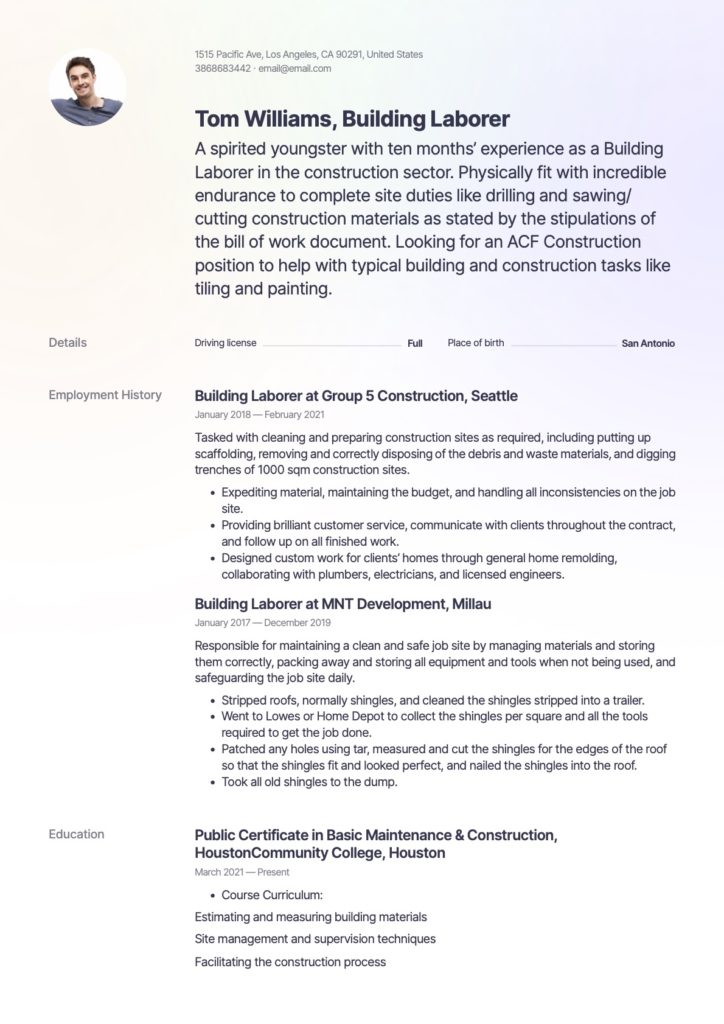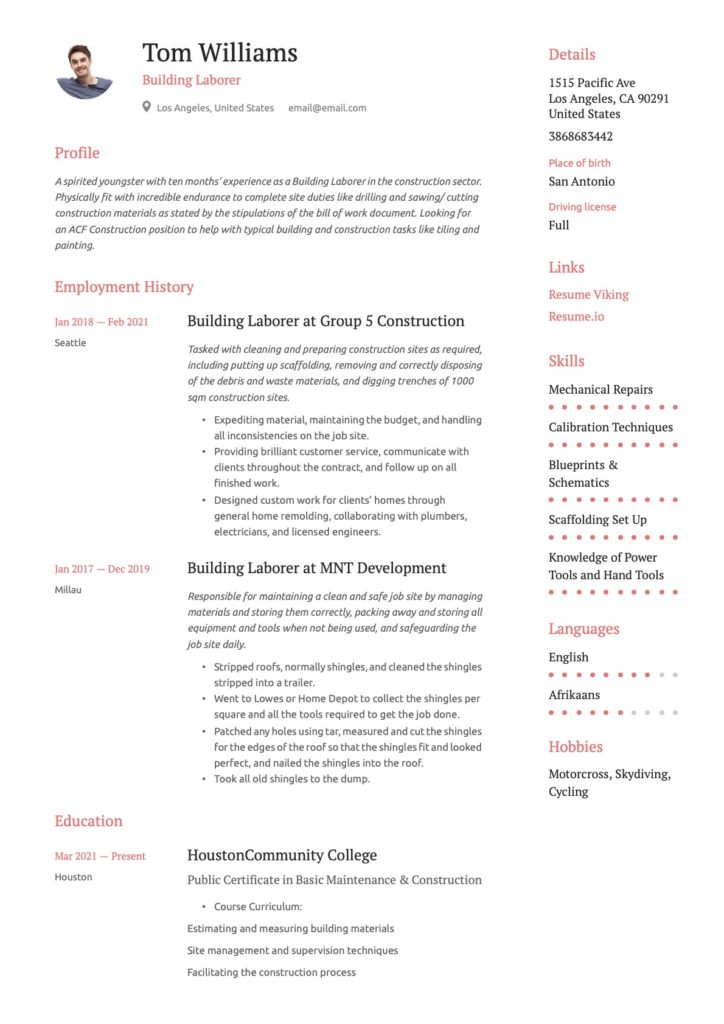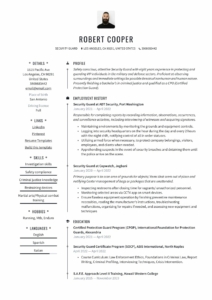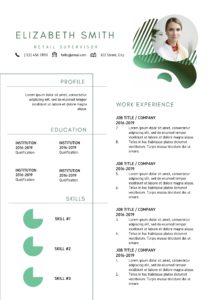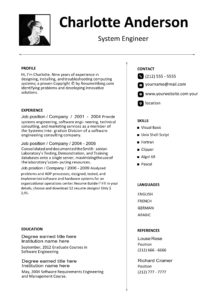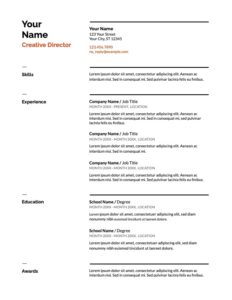Is it time to find that new Building Laborer job? Check out our Building Laborer resume sample that explains everything you should think about when writing your resume.
The competition out there these days can be rough, and although Building Laborers are seen as very strong and handy people, you’ll need more than your strength and endurance to get that interview.
Utilizing what our Building Laborer resume guidelines have to offer will help you present a unique resume.
What you can read in this article
Building Laborer Resume Examples
(Free sample downloads are at the bottom of this page)
Building Laborer Resume Writing Guide
Resume Sections:
- Contact information
- Profile Summary
- Work History
- Achievements
- Education
- Skill Section
- Certification & Licensing
- Extras: Languages/Awards/Publications/Volunteering/hobbies
What to Highlight as Building Laborer
Irrespective of your Building Laborer work experience, employers look for specific things in your resume that indicate if you’re a match for the job being offered.
Regardless if you work on commercial structures, residential building sites, digging trenches for tunnels, or mixing liberal amounts of cement to build highways, there are several important features about your experience/ background that must be showcased in your resume.
First things first, you must indicate if you’re an unskilled, skilled, or semi-skilled Building Laborer.
- Building Laborers who are “skilled” have received specific training or a taught/ trained technical proficiency backed up by certification or special licenses. This includes everyone from a tradesman (plumber, electrician, etc.) to a Red Seal (safety and health).
- You are classified as a “Semi-Skilled Laborer” if you’ve finished post-school training on-the-job training/ courses applicable to your work experience. For instance, you may have achieved an Adult Education program to develop your Spanish, done a commercial truck-driving license, or finished a course in building and construction maintenance.
- You’re considered an “Unskilled Laborer” if you didn’t complete a high school diploma and have worked jobs as a Tiler or Painter etc.
Next, You must explain the general purpose of the job you’re doing. There are many facets to being a building laborer, and job applications are usually specific about what they are looking for. Be clear about what jobs you have done in the past so that the recruiters don’t have to guess. If you worked in more than one aspect within the industry, clearly explain them all.
And then, recruiters want to see all the types of equipment, machinery, and tools you’re proficient with. Explain if you can use power tools or hand tools (including mechanical hoists, earth tampers, cement mixers, air hammers, and heavy-duty drilling machines).
Finally, dedicate a section to your physical abilities. This includes things like the number of pounds you can lift, how well you can climb or your capability of standing for long periods during the day. Excellent hand-eye coordination is essential in manual labor work (The chances for injuring yourself are high if you’re not paying attention). So is the ability to climb scaffolding or ladders and scale a rope down into a utility hole. This is known as multi-limb coordination. To perform your job properly and safely, you will also need brilliant depth perception and vision.
Cheatsheet: Make sure to include the following details:
- Places you’re willing to work. Building Laborer work can be seasonal and might take you out of state, such as packing fish in Canada or assisting with Louisiana's harvesting.
- If you’re a skilled laborer, you might have received specific licenses that allow you to do specialized jobs like Hazmat cleaning jobs.
- Specific machineries you can operate, such as forklifts, load-bearers, industrial vacuums, conveyor belts, large-scale fans, and dryers or washing bay equipment.
- Indicate the environments you’re ok to work in, such as in a mine, underwater maintenance, or at sea on oil rigs/ aircraft carriers.
- Provide your safety experience and if you’re acquainted with the recent ISO standards as well as other regulatory compliance requirements for fields such as GMP for manufacturing and processing plants or FDA (Healthcare/ Medical).
- Say if you’re ok with working shifts. Mostly, it’s the usual 8hr shift, but longer 12hr shifts and overtime on weekends aren’t uncommon in this industry.
- A commercial driver’s license is necessary, as Building Laborers are accountable for transferring recyclable materials and refuse.
Summary & Objective
Employers and recruiters don’t have enough time to sit and read all the resumes that land on their desks. You can make their jobs easier by handing them a solid resume. To do this, you must have a killer career summary/ objective that is concise, has applicable info, and is interesting to read.
Due to the variety of Building Laborer jobs, they all have their jargon and keywords. Utilize these as SEO for your resume to showcase your technical ability, soft skills, years of working experience, and credentials. The more your resume echoes with the job advert and the keywords in the advert, and you’ll seem like a better fit for the job.
Your career summary/ objective must be 4-6 lines long and mustn’t take more than 15 seconds to read through. But what’s the difference between the two?
Recruiters/ employers utilize this intro paragraph to assess your skills and your level of working experience.
If you’ve been in the industry a while, then you must use the career summary. It highlights your experience and the level of your proficiencies.
If you’re a newbie to the game or don’t have all that much experience in the industry, write a career objective. This highlights your career ambitions; it pitches you as a possible candidate and why you’d be the right person for the job.
If you can, quantify your accomplishments in the career summary to highlight your skills.
Pro Tip: Write the career summary/ objective last. Once you have completed the rest of your resume, you’ll have a much better idea of what needs to go into the summary/ objective.
Examples
Summary example 1
“High School graduate with much experience in vocational and volunteering jobs in the building sector. Seeking a Junior Building Laborer job at ACF Construction. Presently finishing courses in Autocad and Revit.”
Summary example 2
“A spirited youngster with ten months’ experience as a Building Laborer in the construction sector. Physically fit with incredible endurance to complete site duties like drilling and sawing/ cutting construction materials as stated by the stipulations of the bill of work document. Looking for an ACF Construction position to help with typical building and construction tasks like tiling and painting.”
Summary example 3
“Highly experienced Building Laborer with seven years’ experience working on high-rise commercial building projects. Skilled with intricate electrical and plumbing activities and proficient in the whole range of building maintenance that follows stipulated protocols and building regulations. A certified Master Builder and presently completing a Welding Certificate.”
Summary example 4
“Experienced Building Laborer looking for a seasonal position at ACF Construction. Skilled with intricate electrical and plumbing activities and proficient in the whole range of building maintenance that follows stipulated protocols and building regulations. A certified Master Builder and presently completing a Welding Certificate.”
Employment History
Depending on the kind of role you fulfill as a building laborer, recruiters will be expecting to see specific proven core responsibilities and skillsets in your resume.
Building Laborer at Group 5 Construction
(Feb 2017 – Dec 2021)
Tasked with cleaning and preparing construction sites as required, including putting up scaffolding, removing and correctly disposing of debris and waste materials, and digging trenches of 1000 sqm construction sites.
- Expediting material, maintaining the budget, and handling all inconsistencies on the job site.
- Providing brilliant customer service, communicating with clients throughout the contract, and following up on all finished work.
- Designed custom work for clients’ homes through general home remolding, collaborating with plumbers, electricians, and licensed engineers.
Building Laborer at MNT Developments
(Feb 2015 – Jan 2017)
Responsible for maintaining a clean and safe job site by managing materials and storing them correctly, packing away and storing all equipment and tools when not being used, and safeguarding the job site daily.
- Stripped roofs, normally shingles, and cleaned the shingles stripped into a trailer.
- Went to Lowes or Home Depot to collect the shingles per square and all the tools required to get the job done.
- Patched any holes using tar, measured and cut the shingles for the edges of the roof so that the shingles fit and looked perfect, and nailed the shingles into the roof.
- Took all old shingles to the dump.
Job Descriptions Samples
Below are more samples of job duties to help you make your job duties list:
Samples:
- Operating a range of power and hand tools, including forklifts, drills, skid loaders, and other tools as instructed by management.
- Cleaning and preparing construction sites as required, including putting up scaffolding, removing and correctly disposing of the debris and waste materials, and digging trenches.
- Shoveling materials to and from construction areas, including dirt and asphalt.
- Following all the safety procedures on the construction site and reporting violations straightaway to management.
- Maintaining a clean and safe job site by managing materials and storing them correctly, packing away and storing all equipment and tools when not being used, and safeguarding the job site daily.
- Loading and unloading construction supplies from trucks, both physically and using the equipment.
- Reporting incidents straightaway to the safety director, HR, or foreman in line with the company's incident reporting procedures.
- Traveling out of town, working on isolated job sites as directed by management.
Accomplishments
This section is super tempting just to copy and paste a number of your daily responsibilities to get this part over and done with. This is such a bad idea. The whole point is to use the resume to set you apart from the rest of the competition. Copying and pasting will not accomplish this, and you may be glanced over by the recruiters. Think about everything you did in your previous job that makes you super proud, then communicate that in punchy, concise sentences.
This section's magic formula is to quantify your accomplishments with numerical values, like a number, percentage, timeframe, or score. Quantifying your achievements provides solid proof of your skills as a Building Laborer.
Quantifying Your Resume
This sounds daunting, but it’s easier than you think. We suggest splitting it into four sections that will showcase your “value-added” to the recruiters when they skim this section. If you can answer questions like “how much?” and “how many?” then you’re well on your way. For example:
1. The number of construction sites you’ve worked on.
Accountable for Hazmat cleaning operations, averaging at seven construction sites weekly.
2. The team size and scope of responsibility.
Responsible for organizing equipment and machinery maintenance on heavy-construction equipment for site teams surpassing 45 construction workersBuilding Laborer Resume & Writing Guide | +17 Templates | PDF & Word.
3. Location size, site, and floor area managed.
A maintenance construction team member servicing shopping malls over 120 000 square feet weekly.
4. Worth of building projects
Working on large offshore rig projects surpassing between $170 million and $290 million.
Accomplishment Statements
What is HOT?
- Every job was kept on schedule. Initiated a new real-time labor inventory system, increasing on-time-completion of projects to 100%.
- Ran a tight shift, ensuring materials and equipment were delivered to all sites with 97% on-time delivery.
- Oversaw on-site work to guarantee productivity and quality. Reduced customer complaints by 65%.
What is NOT?
- Every job was kept on schedule. Initiated a new real-time labor inventory system, increasing on-time-completion of all projects.
- Ran a tight shift, ensuring materials and equipment were delivered to all sites on time.
- Oversaw on-site work to guarantee productivity and quality. Cut customer complaints.
I’m sure you see the difference, right?
Education Section
The nice thing here is that Building Laborers can get jobs without actually having finished any formal type of education. Still, it goes without saying that the more post-school accreditations you possess, the better your chances of getting a job will be.
Those jobs will probably end up paying more as well.
If you completed a degree/ diploma, your layout would look like this: start and finish date, name of degree/ diploma, name of institution, and city/ abbreviated state name.
It’s the same if you only have a high school diploma, only just give your graduation date (and only if you’ve less than three years’ working experience).
Some Examples:
2018 Public Certificate in Basic Maintenance & Construction, Austin Community College, Houston, TX
Course Curriculum:
- Estimating and measuring building materials
- Site management and supervision techniques
- Facilitating the construction process
- Safety and quality standards in the construction industry
2011-2012 HVAC Certificate, Altierus College, Indian Trail, NC
2010 – Trades Diploma in Carpentry, Kirkwood Community College, Cedar Rapids, IA
200- High School Diploma, Reston High School, Ackley, IA
Skills
Potential employers might be looking for different skills, which they will list in the job advert, so please pay attention to the advert. Because of this, you’ll need to tailor your skills section for every job you apply for.
Yeah, it’s a bit more work but trust us, it’s so worth it. And don’t just list your skills in bullet points. That’s boring.
Rather use a skills matrix like the examples below. It’s smart, easy to read, and nice to look at. Make sure, though, to add your soft skills as well as your technical and physical skills. Soft skills are your personality traits that indicate to the recruiter if you’ll be a good fit for the company or not.
Skills Matrix
| Physical Skills | Technical Skills | Soft Skills |
| 1. Manual Dexterity | 1. Numerical | 1. Punctual |
| 2. 20/20 Vision | 2. Reading | 2. Trustworthy |
| 3. Hand/Eye Coordination | 3. Forklift Operation | 3. Communication |
| 4. Multi-Limb Coordination | 4. Power Tools | 4. Detail Orientated |
| 5. Endurance | 5. Mechanical Repairs | 5. Team Player |
| 6. Ability to live 70 pounds | 6. Calibration Techniques | 6. Energetic |
| 7. Nimble & Agile | 7. Safety Regulations | 7. Self-Managed |
| 8. Depth Perception | 8. Blueprints & Schematics | 8. Determined |
| 9. Peripheral Vision | 9. Scaffolding Set Up | 9. Committed |
| 10. Excellent Health | 10. Mine Vehicles | 10. Problem Solving |
Qualifications & Certifications associated with Building Laborers
| Concrete Field-TestingGrade I Certification | Adhesive Anchor Installer Certification | Concrete Flatwork Finisher and Technician |
| Construction TechnicianCertificate | Concrete Strength Testing Technician | Advanced Safety and Health Certificate |
| LEED Green Associate | Rigger Level I | Graduate Remodeler |
| Residential Concrete Foundation Technician | Special Hazards Systems Exam | Welding Apprenticeship |
Optional Extras for Building Laborer Resumes
We know you’re unique, time to prove it in your resume. Every Tom, Dick, and Harry put the main sections mentioned above in their resume. Include an “extras” section to make your resume stand out.
Below, we have given you examples for labor resumes:
- Hobbies and interests
- Licenses and certifications
- Volunteer work on a resume
- Job-related achievements
- Language proficiency levels on a resume
- Freelance projects
- Association memberships
Building Laborer Word Resume Download
Building Laborer Resume Downloads
Professional Information on Building Laborers
Sectors: Construction, Building, Engineering, Residential Developments, Commercial Developments
Career Type: Unskilled, Semi-Skilled, Skilled
Person type: Worker, Laborer, Apprentice, Trainee, Assistant
Education levels: From GED Diploma to post-school qualifications
Salary indication: An average of $16,25 per annum (Indeed)
Labor market: An average growth of 5% between 2019 and 2029 (BLS)
Organizations: Various
